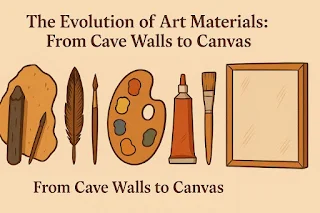From the earliest charcoal drawings on cave walls to sleek digital tablets, art
materials have always reflected both the era and the artist’s vision.
What tools artists choose—and what’s available to them—affects the style,
texture, and even meaning of their work.
Understanding the evolution of materials helps us appreciate how art has
changed and how it continues to transform with time.
Early Human Art Tools
Charcoal and burnt wood were the first drawing tools, used on cave walls like
those in Lascaux, France.
Natural earth pigments like ochre and hematite created early colors.
Artists used fingers, bones, and sticks to apply pigment.
Animal fat or saliva was sometimes mixed in to help pigments bind.
These materials were limited but expressive—and they lasted thousands of years.
Ancient Civilizations and Invention of Brushes
Egyptians used papyrus and natural inks for hieroglyphic writing and
illustration.
Greeks and Romans painted on pottery using slips and minerals.
Chinese artists pioneered brushwork with animal hair, producing fluid ink art
on silk or rice paper.
Natural binders like egg yolk were introduced (egg tempera).
Tools became more refined, but art remained symbolic and functional.
The Renaissance and Oil Painting
The Renaissance brought a revolution in materials:
Oil paint became dominant in Europe due to its flexibility and richness.
Artists used wooden panels first, then moved to canvas stretched on frames.
Pigments were ground from minerals and mixed with oils like linseed.
Artists like Leonardo da Vinci and Jan van Eyck mastered layering,
transparency, and texture using oil.
Industrial Age: Tubes and Mass Production
In the 1800s, pre-mixed paint in metal tubes became available.
This allowed artists to leave the studio and paint outdoors (plein air).
Watercolors, pastels, and acrylics gained popularity due to portability and
variety.
Paper and canvas became mass-produced, cheaper, and standardized.
These innovations led to movements like Impressionism and Expressionism.
Modern Materials and Digital Tools
Today, artists can choose from:
Acrylic paints – fast drying, vibrant, and versatile
Spray paints and markers – used in street and pop art
Digital tablets and styluses – tools like Procreate, Wacom, or iPads
Mixed media – blending traditional and modern elements (ink, collage,
photography)
The only limit now is imagination.
How Materials Shape Art Style
Oil allows blending and detail—used for realism and drama.
Watercolor suggests softness and spontaneity.
Charcoal provides texture and strong contrast.
Digital tools offer speed, layers, and undo buttons—perfect for design and
iteration.
Artists often find their voice through the material they feel most connected
to.
Conclusion
Art materials are more than tools—they are the foundation of style and
expression.
From cave soot to smart styluses, each medium tells the story of its time and
place.
Understanding how materials evolve is key to understanding how art evolves.
Whether you're using charcoal, oil, or a screen, remember: it's not just the
tool—it’s what you do with it.
